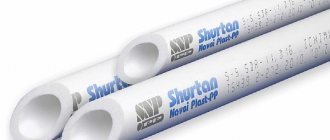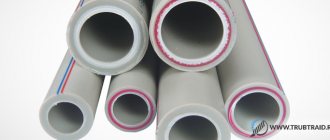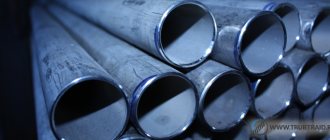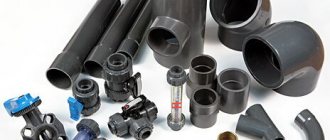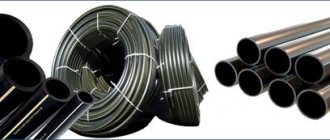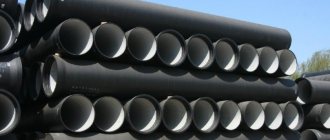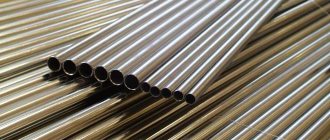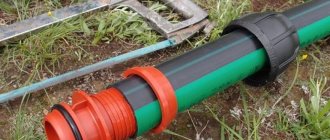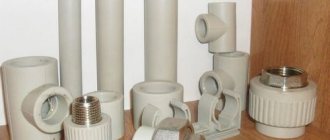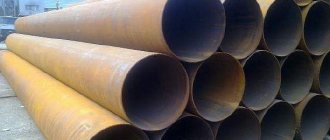Installation of heating with steel pipes is a rather labor-intensive process, which is accompanied by additional welding work. Steel pipes for heating have been widely used for a long time. They can withstand heavy loads when exposed to pressure and various external factors. In addition to high performance, they are inexpensive, so they are in great demand. To install steel pipes, you must first purchase fittings, special equipment and tools. To properly install a heating system with natural circulation, it is necessary to maintain a slope of 10 mm per 1 meter of pipe. This rule applies to the pipeline and water return line. The convenience of working with metal pipes is that they can be laid out at any angle. The pipe can be given the required shape using a blowtorch or gas welding machine. Before installation, you should ensure that there are no manufacturing defects or any damage to the pipes. Non-galvanized pipes must be painted with asphalt varnish in advance. To bend pipes at different angles, you will need a hydraulic pipe bender. The pipe should be fixed in a vice and heated at the bend. When the metal is painted bright red, the pipe can be bent freely. For bending, you can use a regular gas torch. The procedure can be simplified by steel bends and fittings that have the desired shape. When connecting pipes at angles, cast iron fittings can be used.
To order heating installation with steel pipes, call +7 495 205-205-2
Installation of pipe connections is carried out in the following ways:
- Gas-electric welding is used for pipes with smooth ends;
- The sealing gasket is suitable when screwing to achieve a tight joint;
- Bolt fastenings are suitable for flange connections.
Installation using gas-electric welding can only be performed by a highly qualified specialist, if the necessary equipment is available. In order to ensure the impermeability of the joint at high temperatures, asbestos cord and flax strands should be used. The place of the thread must be coated with whitewash or red lead. After this, you need to wrap a thin layer of linen strand. Next, you need to coat it with graphite and tighten the connecting parts tightly. For compaction, you can use FUM tape. The thread space needs to be cleared of debris and tape should be wound around it. You need to screw the fitting or fitting on top. Conventional bolts are used to connect pipes to flanges. Gaskets are installed in the space between the flanges. They will act as a sealing material. To install a pipeline with a coolant, you need to use paronite or asbestos cardboard. The asbestos gasket must be lubricated with graphite, which is pre-mixed in drying oil. The inside of the gasket should not reach 3 mm from the edge of the pipe. All bolt heads must be on the same side of the connection. Steel pipes are a common material used for heating systems.
Heating installation with iron pipes
Heating installation with iron pipes is highly reliable. They are able to withstand large temperature changes.
The advantages of using an iron pipe system are as follows:
- High level of strength;
- Rigidity that allows you to withstand highway slopes.
The disadvantages of iron pipes are as follows:
- Expensive;
- Complex and lengthy installation;
- Susceptibility to corrosive processes.
Installation of pipes should be carried out after studying the wiring system. You need to know exactly where the radiator, additional equipment and boiler are installed. It is necessary to select pipes with a maximum diameter that must correspond to the diameter of the boiler outlet or pipe. After this, you need to decide on the heating wiring diagram. For iron pipes, a two-pipe scheme is usually chosen. This scheme has an average value for material consumption and allows for uniform heating of the radiators.
Heating pipes can be connected in the following ways:
- Muftov;
- Welding;
- Flange;
- Rezbovym;
- Welding.
The most complex, and at the same time widespread method is gas welding. In this case, manual electric arc welding can be successfully used. Gas welding is ideal for creating a bend in a pipe and taking it into the desired shape. Connecting iron heating pipes using welding requires a high level of skill from the performer. This type of work should be entrusted to a specialist.
When performing this type of work independently, you should adhere to a number of rules:
- The preparation of iron pipes and connecting surfaces should be carried out;
- Clean and degrease;
- Edges must be protected inside and out;
- The joints should make an angle of 60 degrees;
- The welding layer should be thoroughly cleaned of any slag that has formed.
A minimum of two layers of welding are used to connect pipes. The number of layers depends on the thickness of the pipes used. The first welding layer must be applied carefully. The edges must be completely melted, and the pipe elements must remain in position. It is possible to apply a second layer only after clearing the first layer of slag.
Threaded connections can be used to connect various devices and during installation of the main line. To perform this connection, many ready-made elements are produced. Threaded connections should be sealed using sealant and tow.
Using tow is the most reliable option, which has been tested by experience and time. You can also use quick-release connectors. They provide easy fixation of all connected elements. Also, threaded connections can be made using flanges and couplings. After installing the pipes, you can fill them with water and check the tightness of the joints. If there are leaks, appropriate measures must be taken to eliminate them. If small leaks are found, they can be sealed with epoxy mixture.
Which pipes to choose for organizing a heating system
Choosing pipes for heating a private house is a responsible process, during which you should take into account the area of the room, whether it is heated or not, what the power of the boiler is, etc. To create a high-quality system, it is better to use polypropylene pipes. They are inexpensive, highly airtight and easy to install. Installation takes little time, unlike calculations and preparatory work. To ensure that the system works for a long time and does not require maintenance, it is better to choose reinforced pipes and taps made of stainless steel.
Metal-plastic pipes are a good, but more expensive option. For installation, all you need is a wrench. The main disadvantage of the products is the low service life of the connections. Such pipes should only be used for heated rooms. If your budget allows, it is better to purchase stainless steel pipes. They are more expensive, but will last at least 100 years.
Heating pipe diameter
Another important stage in organizing the system is choosing the diameter of the pipes for heating a private house. Products are presented in different diameters.
To choose the right one, you should study the system diagram and contact a specialist. The approximate diameter can be calculated independently, taking into account the area of the room and the speed of movement of the coolant.
There is a misconception that installing large-diameter pipes is the key to efficient operation of the system. In fact, due to massive pipes, the pressure in the system decreases or disappears. As a result, water is not able to get into all radiators. Smaller diameter pipes have a higher water flow rate. The optimal value is from 0.2 to 1.5 m/s. If the speed is too high, water bubbling can be heard in the coolant.
To select the appropriate diameter, the thermal power is calculated. For example, for a room with ceilings up to 3 meters high, 100 watts of energy is needed for every square meter. For a room of 20 square meters you will need 2000 W. If you add 20% of the reserve, you get 2400 W. Thermal power is provided by the presence of 1-2 radiators installed under the windows. According to the table, pipes with a diameter of 8-10 mm are suitable for this room. These are approximate calculations, but they will help you calculate your budget when renovating your home.
Heating installation is an important stage that is carried out immediately after the construction of the house. It is worth taking a responsible approach to the choice of pipes, since they are the main elements of the system. They must be strong, durable, resistant to changes in temperature and pressure. When choosing products, it is worth considering a lot of nuances. This is the area of the room, whether it is heated or not, and the method of laying communications. There is no need to skimp on organizing your heating system. High-quality materials will last up to 100 years, maintaining performance characteristics. You should choose products from trusted manufacturers, since even the slightest violation of manufacturing technology significantly impairs performance properties.
Metal heating installation
Installation of metal heating is a justified choice when used under conditions of high internal pressure or large overloads due to temperature changes.
There are the following types of pipes:
- standard;
- reinforced;
- lightweight.
Large thickness pipes should be used in systems with maximum load. They will not bend and require the use of a special welding method that can be handled by a professional. Metal pipes have different shapes and colors. Rolled steel, cast iron and galvanized iron have a black color. Colored pipes are not subject to corrosive processes, but can oxidize over time. The useful life of pipes varies. For example, copper piping has the longest service life. However, such pipes are the most expensive. The main selection criteria are listed below:
- heating specifics (gravity or forced);
- load;
- installation method;
- system configuration;
- pressure;
- coolant type;
- length.
The main advantage of metal pipes is their high resistance to high pressure.
Pipes for heating a private house: how not to make a mistake with your choice
To install a heating system, you can use different types of pipes, available in a wide range of types and prices on the market. But given that this category of product has a long service life, it is important not to make mistakes, since heating pipes must meet the following requirements:
There is a similar article on this topic - Do-it-yourself sewerage installation in a private house.
- ensure the tightness of the system;
- have sufficient strength throughout the entire service life;
- if possible, not be a source of various noises during system operation.
Also, in many cases, you need to pay attention to the appearance of the pipes, since they are often installed externally and can negatively affect the aesthetic perception of the interior.
When choosing heating pipes, you cannot do without taking into account:
- type of system: external or internal, forced or gravity, centralized or autonomous;
- maximum coolant temperature;
- pressure;
- features of the installation of the system, taking into account the complexity of its configuration, as well as the ability, if necessary, to have access to its individual sections for routine or emergency repairs;
- the need to insulate individual areas located on the street or, for example, in the basement.
You should also pay attention to the operational and technical characteristics of the material from which the pipes are made and the manufacturers’ recommendations for their installation and use.
In modern realities, pipes can be used to install a heating system:
- metal (ferrous metal, stainless steel, copper);
- metal-plastic;
- polypropylene;
- PEX pipes made of cross-linked polyethylene.
Each type of product has, as usual, its own strengths and weaknesses, but this will be discussed in detail below.
Types of heating pipes, video:
Installation of steel heating
Installation of steel heating is a classic option for arranging communications. Using such pipes, you can pass coolant with temperatures up to 100 degrees. If they freeze during the cold period, heating with an open fire is allowed. However, steel pipes have disadvantages, which are expressed as follows:
- complex installation of communications;
- lack flexibility;
- additional thermal insulation is required;
- short service life;
- susceptible to corrosive processes.
Installation of steel pipes can be done in two main ways: welding or twisting with threading. As a rule, installation is carried out by professionals who have special equipment.
Main characteristics of steel pipes
Pipes according to the manufacturing method are divided into the following types:
- seamless;
- electric welded
Seamless pipes can be:
- hot-deformed. The production of such pipes is made from hot billets using the pressing method;
- cold-deformed. Pipes of this type are cooled after passing through the press, and it is in this form that they are finally formed.
Steel pipes made using a press
Hot-deformed pipes have a larger wall thickness, which gives the products additional strength.
Electric welded pipes are also divided into two main types:
- spiral seam;
- straight-seam.
Pipes with a straight seam are practically no different from seamless ones in terms of their technical characteristics.
Before manufacturing spiral-welded pipes, sheets of metal are twisted. This production method makes it possible to achieve increased tensile strength of pipes. Spiral welded pipes are used advantageously for laying gas and oil pipelines in areas with increased seismic activity.
Welded pipes
The main characteristics of pipes are the following parameters:
- diameter, which can be internal, external, conventional;
- wall thickness.
Main parameters of steel pipes
All pipes are manufactured in accordance with GOST requirements and can have the following standard sizes:
- electric welded pipes (main GOST 10707-80) can have a diameter of up to 110 mm and a wall thickness of up to 5 mm. The main pipe dimensions and the corresponding thickness are presented in the table;
| Diameter, mm | Wall thickness, mm |
| 5 – 7 | 0,5 – 1,0 |
| 8, 9 | 0,5 – 1,2 |
| 10 | 0,5 – 1,5 |
| 11, 12 | 0,5 – 2,5 |
| 13 – 16 | 0,7 – 2,5 |
| 17 – 21 | 1,0 – 2,5 |
| 22 – 32 | 0,9 – 5,0 |
| 34 – 50 | 1,0 – 5,0 |
| 51 – 67 | 1,4 – 5 |
| 77 – 89 | 2,5 – 5 |
| 89 – 110 | 4 – 5 |
- seamless pipes of various types (main GOST 9567-75). Manufactured standard sizes are presented in the table;
| Hot deformed pipes | Cold-formed pipes | ||
| Diameter, mm | Walls, mm | Diameter, mm | Walls, mm |
| 25 – 50 | 2,5 – 8,0 | 4 | 0,2 – 1,2 |
| 54 – 76 | 3 – 8,0 | 5 | 0,2 – 1,5 |
| 83 – 102 | 3,5 – 8,0 | 6 – 9 | 0,2 – 2,5 |
| 108 – 133 | 4,0 – 8 | 10 – 12 | 0,2 – 3,5 |
| 140 – 159 | 4,5 – 8,0 | 12 – 40 | 0,2 – 5 |
| 168 – 194 | 5 – 8 | 42 – 60 | 0,3 – 9 |
| 203 – 219 | 6 – 8 | 63 – 70 | 0,5 – 12 |
| 245 – 273 | 6,5 – 8 | 73 – 100 | 0,8 – 12 |
| 299 – 325 | 7,5 – 8 | 102 – 240 | 1 – 4,5 |
| 250 – 500 | 1,5 – 4,5 | ||
| 530 – 600 | 2 – 4,5 | ||
The diameters of steel pipes are most often indicated in millimeters, but in practice you can find pipes whose characteristics are presented in inches.
You can convert inch diameter to millimeter diameter (or vice versa) using the “Converter”.
The video will help you understand in more detail the correspondence of inches and millimeters for different types of pipes.
Installation of steel heating pipeline
Installation of a steel heating pipeline can be done in two ways: welding and threading. Since they represent a complex technological process, it is better to entrust such work to external specialists. Using a thread twister, you must first cut the threads at the ends of the joints of the products. After this, they can be connected using fittings, bends and couplings. For threaded connections, windings must be used. To do this, you can use fum tape or polymer thread. Welding is the most reliable method of joining pipes. The work will require welding equipment and knowledge in this area. When welding, the following rules should be followed:
- For galvanized pipes, self-shielding wire with a diameter of 1 mm should be used;
- For non-galvanized pipes, wire with a diameter of 25 mm should be used. Connections of such pipes must be overlapped;
- Welds must be smooth relative to the surface of the products;
- The seams should not have any defects or flaws.
The galvanizing process can occur in two ways: hot and diffuse. In hot dip galvanizing, a steel pipe is completely immersed in molten zinc. During this process, the pipes receive electrochemical and anti-corrosion protection. The diffuse method involves the use of powdered zinc. Thanks to diffusion, atoms penetrate into the intercrystalline structure of the steel pipe. As a result. A stable and very strong connection is formed.
Installation of panel heating radiators
The installation of panel heating radiators has its own characteristics. The internal design of metal fins allows for increased heat dissipation. In the manufacture of radiators, steel is used, which allows for increased convection. The larger the fin area, the higher the efficiency. Radiators quickly warm up the room, since the coolant promotes rapid circulation of water. Therefore, steel radiators are the most efficient devices. Before installation, you should make a design and markings. The position is of great importance during installation, since it affects the service life. You need to accurately calculate the distance from the surface of the battery to the wall. It should be in the range from 3 to 5 cm. It is important to provide for the volume of accumulated air in the heating system. Panel radiators can be attached to walls or mounted on legs. The main task of the master is to establish competent markings. After this, installation of the radiator is carried out very quickly.
Installation of a heating system with steel pipes
Installation of a heating system with steel pipes can be done in the following ways:
- welding;
- twisting with thread cutting.
From a technological point of view, the process of installing a heating system is very complex. Therefore, work of this kind should be trusted to professionals.
Before installation, it is necessary to install risers and lay pipes. When choosing a welding method, you should use self-shielding wire. In some cases, you can use electrodes up to 3 mm in diameter. If the pipes are not galvanized, then overlap welding can be done. The welding process is a painstaking job, since the seams must be smooth without any pores or sagging. During the welding process, pipes that are under pressure can cause difficulties. Therefore, welding must be carried out from the center at the lowest section of the pipe. When using an electrode, you need to position it perpendicular to the welding location. To make vertical seams, you should change the position of the electrode. The method involving twisting and threading is no less effective. In this case, the pipes are connected using angles, couplings and other elements.
Electric welded pipe for heating
Technical characteristics
An electric-welded pipe for heating is produced in the following ways:
- Electric welded with a straight seam.
- Electric welded with a spiral seam.
- Seamless hot-deformed.
- Seamless cold rolled.
And the process itself takes place in the following sequence:
- A sheet of steel wrapped in a roll is unwound and cut into longitudinal strips.
- The strips are twisted into an endless ribbon, and this is necessary for trouble-free production.
- The tape is deformed by rollers, and it turns into a round pipe with an open seam.
- The seam is welded. To do this, several types of welding are used: arc, induction current, laser, plasma.
- The round workpiece is calibrated using rollers.
- Eddy currents or ultrasound constantly monitor the seams.
- Next, cutting into pieces of the required length is performed.
Installation of heating with metal pipes
Installing heating with metal pipes is a labor-intensive process. The smallest errors can affect the service life and render the product unusable. At the initial stage, it is necessary to draw up a competent project and select the material. You should decide on the location of the heating system elements. First you need to prepare the necessary tools and materials. Independent installation of heating with metal pipes is a rather painstaking task. The pipes must be connected using welding or a soldering machine. You can also use the threaded connection method, but it is less reliable. Since the work process requires special equipment and technical knowledge, you should contact a qualified specialist.
Why choose metal for heating systems
For more than twenty years there was practically no alternative to pipes made of steel - carbon (in common parlance, ferrous metal), galvanized, stainless. The use of copper for heating was unheard of at that time; plastic pipes were not mentioned even in progressive scientific journals. Now the situation has changed radically: several types of inexpensive high-tech plastic have greatly displaced metal from heating systems.
However, metal pipes are still indispensable in many situations: when systems operate at very high operating pressures, in hot shops, when high strength is required from pipelines.
Installation of heating pipelines from steel pipes
Installation of heating pipelines from steel pipes can be done in two main ways: welding or twisting with threading. Regardless of the chosen method, initially all risers should be installed and the pipeline should be laid. The welding process places special demands on the quality of the seam. It should have a smooth appearance without sagging or cracks. Holes for pipes are made using milling, cutting or drilling. Installation of a pipeline made of steel pipes can be carried out on a fairly modest budget. However, such products may be subject to corrosion processes. It should be taken into account that the characteristics of materials and assembly rules directly affect the service life of the pipeline. Therefore, you should contact a qualified specialist with experience in this field. If you have the skills and certain tools, you can carry out high-quality installation in a short time.
Specifications
Consumer criteria for steel pipes for heating are determined by their technical characteristics:
- Mode of production. Seamless pipes are considered the most highly durable because the seam becomes a weakened area on the product. Any workpiece is suitable as a coating for electrical wiring, but for a high-pressure line, only seamless types can be installed.
- Diameter. The internal volume determines the dimensions of the pass. This is an important indicator for a pipeline.
- Wall thickness. Structural stability and the ability to withstand increased pressure depend on this.
- Top coating. The galvanized shell protects these materials from corrosive influences. Chrome plating is used as a decorative element in the manufacture of furniture.
- Perforation. This type of pipe is used as casing when drilling wells. True, in this area these materials are gradually giving way to plastic types.
Due to their technical characteristics, these pipes are used in many areas. If you list them, it will be easier to indicate those areas where they are not used.
Installation of steel heating radiators
Installation of steel heating radiators requires taking into account certain nuances. Among them are the distance from the floor, walls and window sills and the choice of location. Steel radiators have special brackets with which they are hung on mounts. To make the structure stable, a special floor bracket is used. It acts as a stand on which the battery rests. The number of fasteners depends on the specific design. Installation of a steel heating panel requires a horizontal position. This allows the coolant to be evenly distributed throughout the system without freezing in a certain part. Any deviation from the horizontal position reduces work efficiency.
Steel heating pipes
Steel has been widely used for heating for a long time. They are special in that they can withstand significant loads under pressure and exposure to external factors. It is also important that they are inexpensive.
In this case, liquid whose temperature exceeds one hundred degrees can be passed through metal products. If they freeze, they cannot be warmed up even with an open flame.
Of course, this material is not without its drawbacks:
- The average service life (depending on operating conditions) is fifteen years.
Pipe corrosion - Not resistant to corrosion.
- Additional thermal insulation is needed.
- Difficulty in giving the desired geometric shape and installation.
In some cases, it makes sense to correct certain deficiencies if it makes a difference. For example, if the distance from the heating device to the radiator is significant. Insulation helps retain heat, making the system more efficient.
In some cases, galvanization can save the day and help avoid corrosion. However, in this case the use of antifreeze is excluded.
